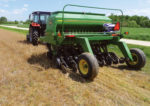Advertise Follow Us
Items Tagged with 'Austrian winter peas'
ARTICLES
Ohio no-tiller Nathan Brause says unspectacular profits shouldn’t deter adding wheat to crop rotation.
Read More
Committing to Cover Crops Brings Added Benefits to No-Till
After seeing the changes cover crops made to one farm, the Eberhard family is going all in to take out weeds and secure and produce nutrients.
Read More
Residue, Water Management Key to Winning No-Till Corn Yields
A protective blanket of ground cover and better water infiltration allow Tyler Franklin to irrigate crops with less water and boost soil health.
Read More
What I've Learned from No-Tilling
Taking the Next Step with No-Till
Already a multi-decade experienced farmer when he started no-tilling, Don Bahe continues to embrace change on his Iowa corn and soybean farm.
Read More
Keep Covers in Your Rotation Without Breaking the Bank
No-tillers can reduce the cost of their cover-crop program and still keep most of the benefits by closely examining their seeding rates and methods and potentially trimming back mixes.
Read More
Diversity, Technology Boost Fertility Use, Crop Performance
Working in the Lake Erie watershed with heavy clay soils, no-tillers Les and Jerry Seiler are increasing productivity with their dedication to no-till, crop diversity and precision technology.
Read More
Three Keys To Controlling Weeds With Cover Crops
A weed scientist shares why effective cover crop termination, choice of weeds a grower is targeting and being mindful of herbicide carryover are crucial for controlling weeds with covers.
Read More
Finding Your ‘ROI’ With Cover Crops In No-Till Systems
Cover-crop expert Dave Robison is working to generate some hard numbers to quantify the much-touted benefits of individual covers and cover-crop mixes on no-till operations.
Read More












